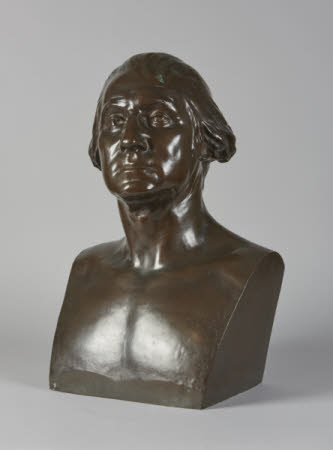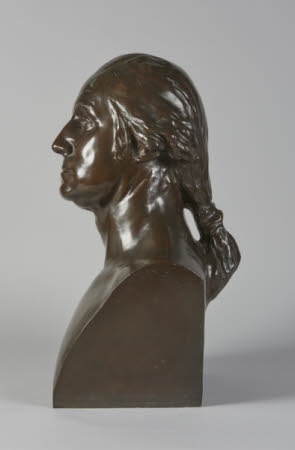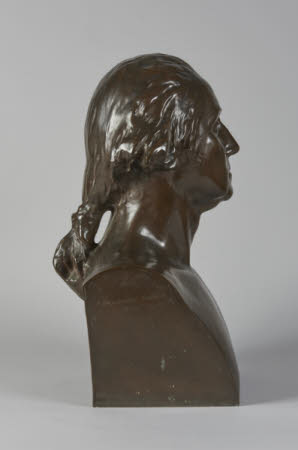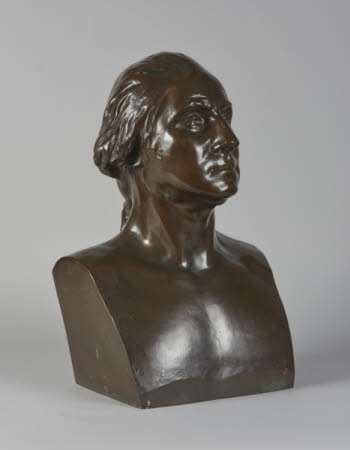George Washington (1732-1799)
Ferdinand Barbedienne (Calvados 1810 - Paris 1892)
Category
Art / Sculpture
Date
c. 1880 - c. 1910
Materials
Bronze
Measurements
495.3 mm (Height)
Place of origin
Paris
Order this imageCollection
Washington Old Hall, Tyne and Wear
NT 591627
Summary
Bronze, George Washington (1732–99), Ferdinand Barbedienne (St Martin-de-Fresnay 1810 – Paris 1892), cast after a model by Jean-Antoine Houdon (Versailles 1741 – Paris 1828), c. 1880-1910, purveyed by Tiffany & Co. (1837 – present), inscribed on truncation proper right shoulder, ‘F. BARBEDIENNE. FONDEUR | PARIS’ and stamped ‘TIFFANY & CO.’ Inscribed on back of truncation, bottom left, '204 | CH. C.' A terminal bust portrait of George Washington after a model by Jean-Antoine Houdon of 1785 at Mount Vernon (inv.no. W-369), cast in bronze with a dark brown patina by Ferdinand Barbedienne, purveyed by Tiffany & Co., New York. See also notorised copy after Houdon by James Wilson Macdonald, cast by the Henry Bonnard Bronze Co. Foundry, c. 1898 (NT 591628).
Full description
The model derives from a life cast of George Washington’s face taken by Houdon at Mount Vernon in 1785. The French neo-classical sculptor had travelled to Virginia on the recommendation of his American clients Thomas Jefferson and Benjamin Franklin who were then living in Paris. Houdon arrived at Mount Vernon on 2 October 1785 and stayed for two weeks, studying Washington’s facial features, expressions, and countenance. He created the life mask on 10 October, a process meticulously documented in Washington’s diaries, and then prepared a cast of the mask which would form the basis of the terracotta model (Mount Vernon, W-369), nearly twenty other busts and a full-size statue now in the State Capitol of Richmond, Virginia. Ferdinand Barbedienne was a French metalworker who established one of the most renowned and prolific foundries of the Belle Epoque. The foundry was particularly known for its high-quality bronze reproductions of celebrated sculptures. After Barbedienne died in 1891 the foundry was taken over by his nephew Gustave Leblanc who established agencies promoting Barbedienne products in Britain, Germany and the United States of America. Continuing in his uncle’s vein, Leblanc actively purchased models and production rights from sculptors and estates. This bust – similar to a cast bequeathed to the Metropolitan Museum of Art in 1908 (inv.no. 08.165) – was purveyed by the luxury retailer Tiffany & Co in New York. Washington Old Hall incorporates the medieval foundations of the property owned by the ancestors of George Washington (1732–99), the first President of the United States, founding father of the American Constitution and holder of enslaved people in Mount Vernon, Virginia. Alice Rylance-Watson 2020
Marks and inscriptions
Truncation, proper right shoulder: F. BARBEDIENNE. FONDEUR | PARIS Truncation, proper right shoulder: TIFFANY & CO Truncation, back, bottom left : 204 | CH. C.
Makers and roles
Ferdinand Barbedienne (Calvados 1810 - Paris 1892), founder after Jean-Antoine Houdon (Versailles 1741 – Paris 1828), sculptor






